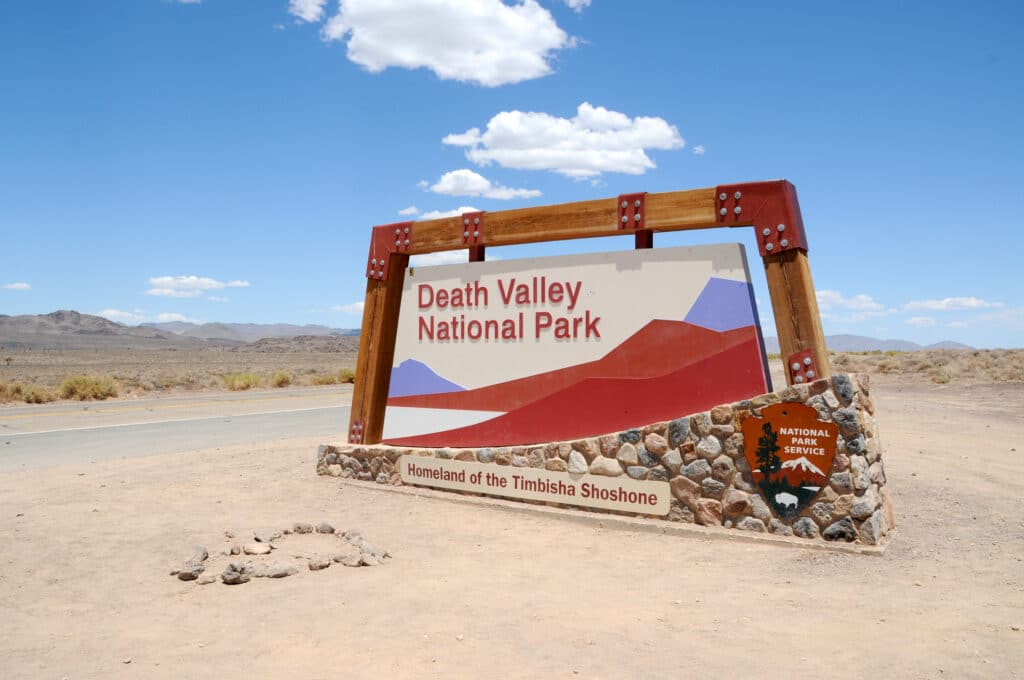
Death Valley National Park requires an entrance permit, and the current fees are straightforward. A 7-day pass costs $30 per private vehicle (covering all passengers), or $25 per motorcycle. If you arrive on foot or bicycle, the fee is $15 per person, while children under 16 years old enter free. For frequent visitors, an annual Death Valley pass is available for $55. All major entry points only accept credit/debit cards – no cash is accepted at the self-service kiosks or visitor centers.
The park itself is open 24 hours a day, every day of the year, including holidays. There are no gates that close overnight, so you can explore at any hour (though summer afternoons are dangerously hot). Furnace Creek Visitor Center operates daily from 8:00 AM to 5:00 PM, offering maps, exhibits, and rangers on duty. Seasonal differences mainly affect comfort rather than access: spring and winter have mild temperatures and more visitors, whereas summer sees extreme heat and thinner crowds. We visited on 27 June 2025, and all figures were valid then.
Park Essentials & Attractions
What on earth could survive in such a furnace? Quite a lot, as it turns out. Death Valley is infamous as one of the hottest, driest places on the planet – it holds the record for the highest air temperature ever recorded (134°F/57°C) and averages barely 2 inches of rain per year. Its name sounds forbidding, yet we quickly learned that this desert is very much alive. In hidden pockets fed by springs, we found clusters of green where tiny pupfish dart in rare pools and wildflowers bloom after elusive rainstorms. Even on the sun-baked salt flats and parched hills, hardy creosote bushes, cacti and bright desert holly somehow endure, and we even spotted a few darting lizards and a lone coyote trotting across the road – honestly, we didn’t expected to see any animals in such brutal heat.
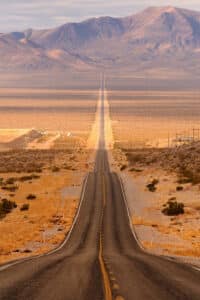
Long desert highway leading into Death Valley National Park from Beatty, Nevada.
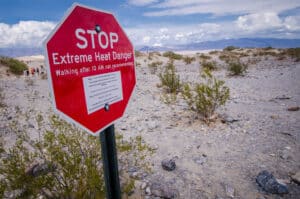
A sign in Death Valley National Park
Geologically, Death Valley is a land of extremes and superlatives. It’s the lowest point in North America at Badwater Basin (282 feet below sea level), and yet only 15 miles away towers Telescope Peak at 11,049 feet – sometimes capped with snow while the valley floor bakes. The valley itself is a gigantic graben (a sunken block of Earth’s crust) cradled between stark mountain ranges.
Over millions of years, those mountains eroded and ancient lakes evaporated, leaving behind the vast salt flats that crunch under your feet today. Much of the park feels otherworldly, like a playground of surreal salt pans, painted hills and towering dunes that could be straight out of a sci-fi movie. We stood in awe at the rainbow-colored badlands of Artist’s Palette and the golden sands of Mesquite Dunes, feeling like tiny specks in a 5,270-square-mile wilderness.
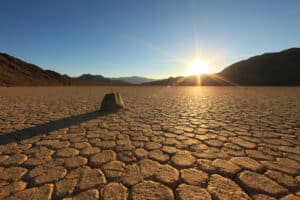
Death valley national park, Nevada, Usa
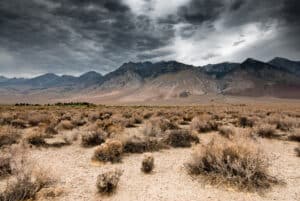
Panoramic view of dark clouds in death valley national park, Nevada, Usa
Despite its harshness, Death Valley harbors a fragile ecosystem that park rangers work hard to protect. Over a thousand plant species (several found nowhere else) are scattered across its elevations, and iconic desert animals roam the park. Desert bighorn sheep tiptoe on distant ridges, elusive kit foxes and bobcats emerge at dusk, and yes, the endangered desert tortoise still burrows in the remote gravelly fans. One fascinating creature, the Devils Hole pupfish, survives in a single water-filled limestone cavern on the park’s edge – a testament to nature’s resilience. We learned that scientists closely monitor and safeguard these rare fish, and the park even limits access to their habitat to ensure their survival.
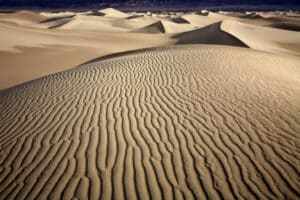
Sand Dunes. Death Valley National Park, California
Humans have called this place home long before it was a park. The Timbisha Shoshone people lived in and around Death Valley for at least a millennium, adapting ingeniously to the desert’s rhythms. In the more recent past, prospectors passing through in 1849 gave the valley its ominous name. Legend has it that as one ragged group finally escaped, one man turned back to utter, “Goodbye, Death Valley” – and the name stuck. By the 1880s, boomtowns and borax mines popped up, with 20-mule teams hauling wagonloads of borax across the sands (traces of those old camps and a historic borax mill are still visible). Real protection came later: Death Valley was declared a National Monument in 1933 and finally elevated to National Park status in 1994, now encompassing roughly 3.4 million acres of protected land. In fact, UNESCO recognized its importance even earlier by designating the region as an international biosphere reserve in 1984.
For visitors like us, the park offers more to do than just endure the heat – it’s an adventure playground. Popular hiking trails range from easy boardwalks to strenuous mountain climbs. We trekked the Golden Canyon trail through narrows of gold-hued rock to reach the towering Red Cathedral formation, and it was well worth the sweat.

Sand Dune Formations in Death Valley National Park, California

Zabriskie Point, Death Valley National Park, California
Another morning we wandered Mosaic Canyon’s polished marble walls, marveling at how water can sculpt stone into art. If you’re very ambitious (and start before dawn), the trail to Telescope Peak will lead you from desert to pine forest and panoramic summit views. Most casual visitors stick to shorter walks or roadside highlights, but even a quick stop yields jaw-dropping sights. Some only budget a single day here, we recommend staying at least two full days to really appreciate the scale. We spent two jam-packed days and still felt we were leaving things unseen – the park is kinda endless in that sense!
Area Highlights: Trails & Restaurants
Death Valley rewarded us with countless unforgettable sights, both within the park and just beyond its borders. From dawn hikes to midnight stargazing, we made the most of every hour. Here are some of the highlights we experienced:
-
Badwater Basin – We strolled across a blinding white expanse of salt at the lowest point in North America, at 86 m (282 ft) below sea level. The hexagonal salt-crust patterns looked like a giant frozen honeycomb beneath our boots.
-
Zabriskie Point – At sunrise we watched the badlands light up in shades of gold and pink. The short walk up from the parking lot led to a famous panorama of eroded hills that was absolutely worth the 5 AM wake-up.
-
Dante’s View – A 5,475 ft-high overlook on the valley’s rim. We were gonna catch first light up there, and in the thin, cool air we could see the entire valley floor spread out below, from salt flats to sand dunes – a view that made us gasp.
-
Mesquite Flat Sand Dunes – In the evening we wandered these tall dunes near Stovepipe Wells. The sand was still warm between our toes as we climbed up for a sunset, and we even heard a low “booming” sound when the wind shifted the dunes (a phenomenon nicknamed the singing sands).
-
Artist’s Drive & Palette – This scenic loop road took us through a canyon painted with pastel mineral hues. We hopped out at Artist’s Palette overlook to scramble around the multi-colored hills splashed green, lavender and pink – it felt like walking on a painter’s palette indeed.
-
Ubehebe Crater – Up in the northern part of the park, we hiked along the rim of this half-mile wide volcanic crater. The sight of black volcanic cinders and orange layers plummeting 600 feet down was unreal. Our legs burned climbing back up, but the dramatic view into the Earth was a trip highlight.
-
Scotty’s Castle – This historic 1920s mansion lies in a lush desert oasis in the far north of the park. It’s been closed to the public since flash floods damaged it in 2015, but we peeked through the gates at the Spanish-style villa. Even in disrepair, it exudes an intriguing, quirky grandeur in the middle of nowhere.
-
Golden Canyon Trail – One of our favorite hikes, this 2-mile (3.2 km) trail started near Badwater Road and led us through twisting canyons of yellow and orange rock. We started at dawn to avoid the heat and had the trail mostly to ourselves, exploring side canyons and taking far too many photos of sun-lit cliffs.
-
Darwin Falls – Believe it or not, there’s a waterfall here! On the far western edge of the park, we followed a modest trail through a narrow green canyon (near Panamint Springs) and discovered a small but lush waterfall and pool. Dragonflies buzzed around and reeds swayed – a tiny Eden hidden in the desert.
-
Rhyolite Ghost Town – Just outside the park in Nevada, we visited this abandoned gold-rush town on our drive out. We wandered among crumbling stone buildings and eerie outdoor sculptures (including ghostly human figures made of plaster). The silence and desert mountains around gave it an oddly beautiful, haunted atmosphere.
-
Crowbar Café & Saloon (Shoshone) – Feeling hungry after a long day on the trails? We sure were, and this tiny village just south of the park was our savior. We sat down to hearty burgers and icy drinks at the Crowbar Café, a rustic roadhouse bedecked with Old West memorabilia. The homemade chili there hit the spot, and we chatted with fellow dusty travelers at the bar.
-
Beatty, NV – On the park’s east side, the town of Beatty welcomed us with a much-needed dose of civilization. We grabbed a bowl of famous chili and a cold beer at the Happy Burro Chili & Beer (a funky little saloon), then treated ourselves to milkshakes at the Death Valley Nut & Candy Company – part gas station, part candy store and 100% a great road-trip stop for snacks. After roughing it in the desert, we really appreciated these simple delights.
After all our adventures, we drove off into the sunset utterly exhausted, a little dusty, but very happy. Death Valley had surprised us at every turn – from its burning afternoons to its strangely cold nights under brilliant stars. It’s a place that challenged us and rewarded us in equal measure. We left with memories of otherworldly landscapes and a humble respect for the desert’s silent beauty, already dreaming of our next visit.
Sorry, there were no items that matched your criteria.

